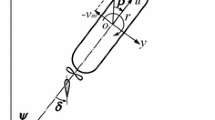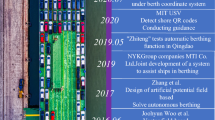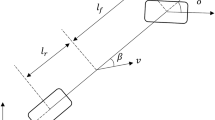Abstract
In order to solve the difficulty of modeling the unmanned surface vehicle (USV) nonlinear maneuver model, a combination identification method of linear hydrodynamic coefficients and nonlinear hydrodynamic coefficients based on support vector machine (SVM) is proposed. The identification principle of USV hydrodynamic coefficients is briefly introduced and a regression algorithm of the SVM is derived for the USV maneuver model. Then, the linear hydrodynamic coefficients of the hull are identified by using a series of USV turning test data at small water-jet angles. And the large water-jet angle turning motion test data and the identified linear hydrodynamic coefficients are used to identify the nonlinear hydrodynamic coefficients for USV. The fourth-order Runge-Kutta method is used to design the USV maneuver simulation program, and a series of USV turning motion simulation experiments are carried out. The simulation data is compared with the corresponding USV sea trial data. Through comparative analysis, it is shown that the USV maneuver mathematical model established in this paper can describe the maneuverability of the USV. It is feasible to use the combination method of SVM to identify the hydrodynamic coefficient of USV.
Similar content being viewed by others
References
J. A. K. Suykens and J. Vandewalle, Recurrent least squares support vector machines, IEEE Transactions on Circuits and Systems I: Fundamental Theory and Applications, 47 (7) (2000) 1109–1114.
M. A. Abkowitz, Measurement of hydrodynamic characteristic from ship maneuvering trials by system identification, Transactions of Society of Naval Architects and Marine Engineers, 88 (1980) 283–318.
X. R. Hou, Z. J. Zou and C. Liu, Nonparametric identification of nonlinear ship roll motion by using the motion response in irregular waves, Applied Ocean Research, 73 (2) (2018) 88–99.
Y. P. Yan, Calculation and hydrodynamic coefficient modeling of open-frame underwater robot, Journal of Engineering, 42 (9) (2021) 1972–1986.
B. J. Lyu, B. Huang and L. K. Peng, A SR-UKF-based method to identify submarine hydrodynamic coefficients, China Ship Research, 16 (3) (2021) 44–49.
W. H. Sun, Identification method of Hydrodynamic coefficients of ship structure nonlinear rolling motion based on Hilbert transform, Master’s Thesis, Ludong University, China (2021).
Y. Jiang et al., Identification modeling and prediction of ship maneuvering motion based on LSTM deep neural network, Journal of Marine Science and Technology, 27 (2022) 125–137.
P. F. Xu, C. Cheng, H. Cheng, Y. Shen and Y. Ding, Identification-based 3 DOF model of unmanned surface vehicle using support vector machines enhanced by cuckoo search algorithm, Ocean Engineering, 197 (2020) 106898.
S. K. Bhattacharyya and M. R. Haddara, Parametric identification for nonlinear ship maneuvering, Journal of Ship Research, 50 (3) (2006) 197–207.
T. Perez and T. I. Fossen, Practical aspects of frequency domain identification of dynamic models of marine structures from hydrodynamic data, Ocean Engineering, 38 (2–3) (2011) 426–435.
M. R. Haddara and Y. Wang, Parametric identification of maneuvering models for ships, International Shipbuilding Progress, 46 (445) (1999) 5–27.
S. Sutulo and S. C. Guedes, An algorithm for offline identification of ship maneuvering mathematical models from free-running tests, Ocean Engineering, 79 (2014) 10–25.
D. Hess and W. Faller, Simulation of ship maneuvers using recursive neural networks, 23rd Symposium on Naval Hydrodynamics, Val de Reuil (2000).
W. Luo and Z. Zou, Parametric identification of ship maneuvering models by using support vector machines, Journal of Ship Research, 53 (1) (2009) 19–30.
W. Luo and Z. Zou, Elimination of simultaneous drift and sensitivity analysis in the hydrodynamic modeling of ship manoeuvring, Journal of Shanghai Jiaotong University, 42 (8) (2008) 1358–1362.
X. Zhang and Z. Zou, Identification of Abkowitz model for ship manoeuvring motion using ε-support vector regression, Journal of Hydrodynamics, 23 (3) (2011) 353–360.
F. Xu et al., Parametric identification and sensitivity analysis for autonomous underwater vehicles in diving plane, Journal of Hydrodynamics, 24 (5) (2012) 744–751.
X. Cui et al., Seafloor habitat mapping using multibeam bathymetric and backscatter intensity multi-features SVM classification framework, Applied Acoustics, 174 (2021) 107728.
G. N. Kouziokas, A new W-SVM kernel combining PSO-neural network transformed vector and Bayesian optimized SVM in GDP forecasting, Engineering Applications of Artificial Intelligence, 92 (2020) 103650.
A. J. Smola and B. Scholkopf, A tutorial on support vector regression, Statistics and Computing, 14 (3) (2004) 199–222.
S. Adachi and T. Ogawa, A new system identification method based on support vector machines, IFAC Proceedings Volume, 34 (14) (2001) 181–186.
V. N. Vapnik and V. Vapnik, Statistical Learning Theory, Wiley, New York (1998).
V. Vapnik, Universal learning technology: support vector machines, NEC Journal of Advanced Technology, 2 (2) (2005) 137–144.
W. Luo and J. Ren, On the identification of coupled pitch and heave motions using support vector machine, 2016 Chinese Control and Decision Conference (2016) 3316–3321.
W. Luo and W. Cai, Modeling of ship maneuvering motion using optimized support vector machines, Fifth International Conference on Intelligent Control and Information Processing (2014) 476–478.
Y. T. Dai, X. R. Zhao and L. Q. Liu, Parameter identification of ship vertical motions using improved particle swarm optimization, Journal of Ship Mechanics (2010) 44–50.
Y. T. Dai and L. Q. Liu, On the identification of coupled pitch and heave motions using opposition-based particle swarm optimization, Mathematical Problems in Engineering (2014) 221–231.
K. Zheng, Y. Chen, Y. Jiang and S. Qiao, A SVM based ship collision risk assessment algorithm, Ocean Engineering, 202 (2020) 107062.
Y. Xue et al., System identification of ship dynamic model based on Gaussian process regression with input noise, Ocean Engineering, 216 (2020) 107862.
M. Mohammadi et al., A comprehensive survey and taxonomy of the SVM-based intrusion detection systems, Journal of Network and Computer Applications, 178 (2021) 102983.
H. Yasukawa et al., Evaluations of wave-induced steady forces and turning motion of a full hull ship in waves, Journal of Marine Science and Technology, 24 (2018) 1–15.
P. Wang et al., Numerical and experimental study on the maneuverability of an active propeller control based wave glider, Applied Ocean Research, 104 (2020) 102369.
G. Wu, Study of the maneuverability and intelligent control for unmanned surface vehicle, Doctor’s Thesis, Harbin Engineering University, China (2011).
T. I. Fossen, Handbook of Marine Craft Hydrodynamics and Motion Control, John Wiley and Sons, New York (2011).
Acknowledgments
This work was funded by Research Fund from Science and Technology on Underwater Vehicle Technology Laboratory (Grant number 6142215190104), and National Natural Science Foundation of China (Grant number 51309148).
Author information
Authors and Affiliations
Corresponding author
Additional information
Gongxing Wu is an Assistant Professor of the College of Ocean Science and Engineering, Shanghai Maritime University, Shanghai, China. He received his Ph.D. in Naval Architecture and Marine Engineering from Harbin Engineering University. His research interests include ship maneuvering, system identification, intelligent control. His aim is to improve the intelligent port automation, ship navigation performance and automation level.
Jiawei Zhang is currently pursuing the Master’s degree in Shanghai Maritime University (SMU), Shanghai, China. His research direction is the informatization design of unmanned surface vehicle.
Guofu Li is currently pursuing the Master’s degree in Shanghai Maritime University (SMU), Shanghai, China. His research direction is the autonomous avoidance of surface drones.
Rights and permissions
About this article
Cite this article
Wu, G., Zhang, J., Li, G. et al. Identification method of nonlinear maneuver model for unmanned surface vehicle from sea trial data based on support vector machine. J Mech Sci Technol 36, 4257–4267 (2022). https://doi.org/10.1007/s12206-022-0743-0
Received:
Revised:
Accepted:
Published:
Issue Date:
DOI: https://doi.org/10.1007/s12206-022-0743-0




